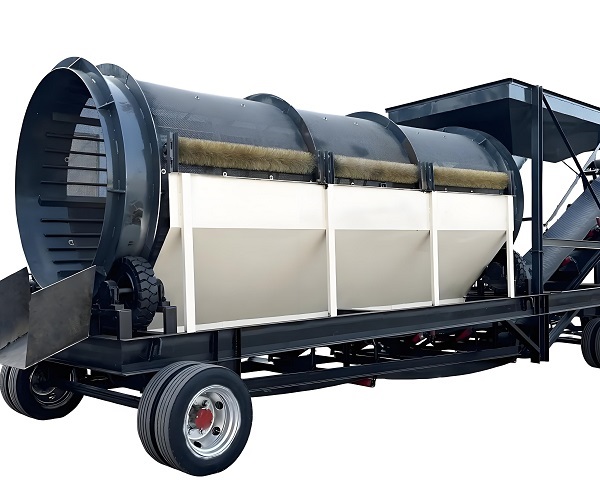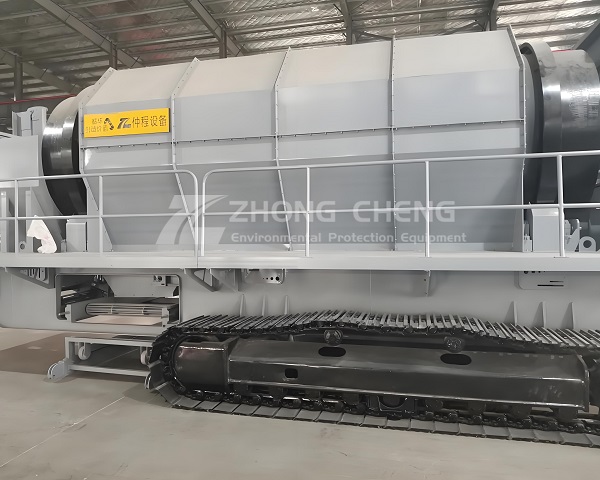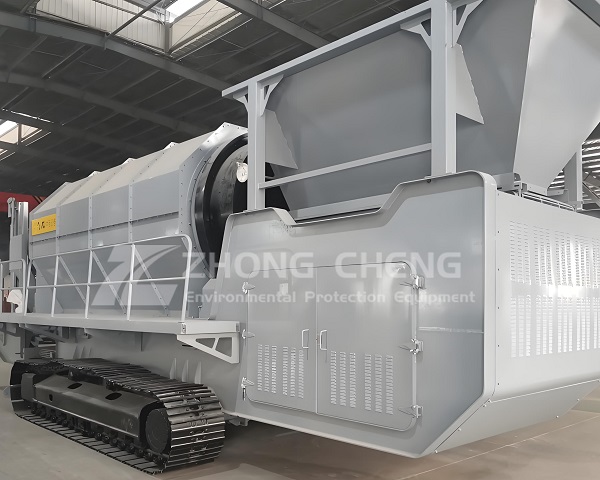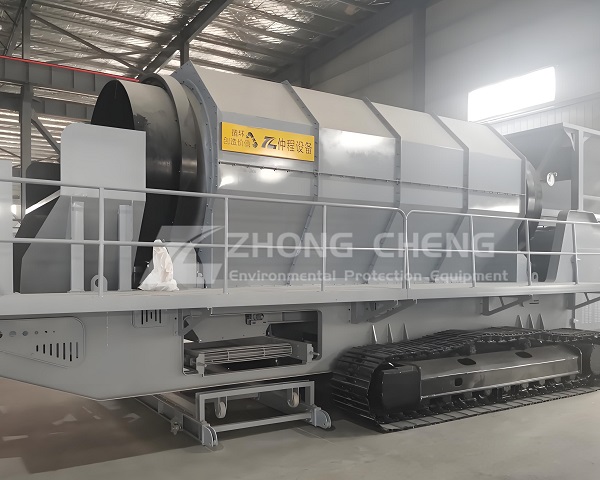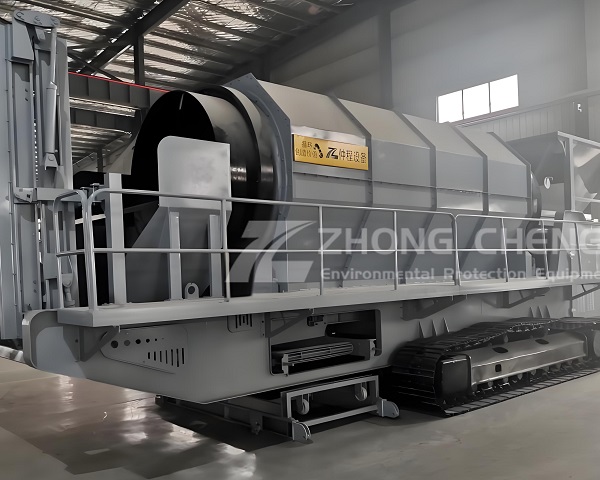A Trommel Screen is a rotary drum screening machine widely used in waste processing, mining, and construction industries. It efficiently separates materials by ......
What is the Mobile Trommel Screen
In the context of growing demand for resource recycling and environmental protection, Mobile Trommel Screen has become a key equipment for construction waste treatment, mining and solid waste management with its advantages of efficient screening, flexible movement and green construction. This article will deeply analyze its technical characteristics, application scenarios and industry value to help upgrade the industry.
1. Equipment definition and core functions
Mobile Trommel Screen is a mechanical device that integrates screening and movement functions. It uses a rotating cylindrical screen drum to classify materials by particle size. Its core structure includes a drive motor, an inclined screen drum, a screen mesh and a mobile chassis. The material is layered in the screen drum as it rotates. Fine-particle materials are discharged through the screen holes, and coarse-particle materials are discharged from the end. The device has both screening accuracy and flexibility, and is suitable for material processing needs in multiple scenarios.
2. Technical features and performance advantages
The equipment adopts a modular design and supports tire or crawler mobile chassis, which can be quickly transferred to different work sites; the screen drum speed (20-30 RPM) and inclination (5°-15°) are adjustable to adapt to the characteristics of different dry and wet materials; the screen hole size (5mm-100mm) can be customized on demand to ensure classification accuracy. Its closed screening structure combined with dust removal device effectively reduces dust pollution, and the noise is ≤85 decibels, meeting environmental protection construction standards. In addition, the equipment supports 24-hour continuous operation, with a production capacity of 20-500 tons/hour, significantly improving engineering efficiency.
3. Diverse application scenarios
Mobile Trommel Screen is widely used in construction waste recycling (separation of concrete, bricks and slag), mining (pre-screening of ore, removal of impurities), municipal solid waste treatment (separation of organic waste and inorganic matter), agricultural composting (screening of raw materials, removal of impurities) and garden engineering (soil improvement, stone removal). For example, in the treatment of construction waste, the equipment can convert waste into recycled aggregates, which can be directly used in road base construction; in mining scenarios, pre-screening can reduce the subsequent crusher load, reduce energy consumption and wear.
4. Industry value and development trend
The equipment promotes circular economy and sustainable development by reducing material transportation costs, manual sorting intensity and environmental pollution. Its economic efficiency (reducing comprehensive costs by more than 30%) and environmental protection (resource utilization rate exceeds 90%) are equally important, making it a core equipment in resource recycling, municipal engineering and agriculture. In the future, with the integration of intelligent technologies (such as automatic sieve hole adjustment and remote monitoring), Mobile Trommel Screen will further improve the convenience of operation and screening efficiency, and help the industry transform towards green and efficient.
Operating principle of Mobile Trommel Screen
Working principle of Mobile Trommel Screen:
1. Material conveying and preliminary dispersion mechanism
Mobile Trommel Screen feeds the material evenly into the rotating screen drum through the front feeding device (such as a vibrating feeder or a belt conveyor). The screen drum is installed at an inclination angle of 5°-15°, and gravity and rotating centrifugal force are used to make the material tumble continuously in the drum to avoid clogging of the screen holes caused by accumulation. The material is initially dispersed during the tumbling process, and fine particles are more likely to contact the screen, laying the foundation for subsequent classification.
2. Multi-stage screening and precise particle size classification
The surface of the screen drum is covered with multiple layers of screens with different apertures (such as 5mm, 10mm, 20mm), and the material passes through the screen layer by layer as the screen drum rotates. Fine particles smaller than the size of the screen hole (such as sand and fine stone) pass through the screen, fall into the bottom collection device (such as a screw conveyor) and are output as finished products; coarse particles larger than the screen hole (such as stones and bricks) move along the inner wall of the screen drum to the end and are discharged through the discharge port. The multi-layer screen design supports the separation of multiple particle sizes at the same time, meeting the classification requirements of different scenarios.
3. Optimization of impurity removal and anti-blocking technology
For wet, sticky or impure materials, the equipment integrates multiple anti-blocking mechanisms: the spray system sprays water on the inner wall of the screen drum or at the material inlet to reduce the viscosity of the material; the variable speed adjustment function dynamically adjusts the screen drum speed according to the material characteristics (such as reducing it to 15-20 RPM when processing wet materials), prolonging the screening time to reduce blockage; wear-resistant linings (such as rubber or steel plates) protect the screen from wear by hard impurities (such as metal) and extend the life of the equipment.
4. Power drive and dynamic parameter adjustment
The equipment is driven by a motor or diesel engine, and the power is transmitted to the screen drum main shaft through a reducer. The core parameters (speed, inclination, mesh size) can be adjusted in real time according to the material characteristics: increase the speed (25-30 RPM) when processing dry materials to improve efficiency; reduce the speed and enable spraying when processing wet materials; increase the mesh size and adjust the inclination when processing large-size materials to optimize the discharge speed of coarse particles. This dynamic adjustment capability ensures that the equipment can adapt to complex working conditions.
5. Environmental protection, energy saving and efficient operation design
The screening process adopts a closed structure, combined with a negative pressure dust removal device to control the dust concentration below 30mg/m³, and the noise is ≤85 decibels, meeting the environmental protection standards of urban construction. The equipment reduces unit energy consumption (about 0.5-1.2kWh/ton) by optimizing the weight and drive power of the screen drum, while supporting 24-hour continuous operation, with a production capacity of 20-500 tons/hour. Its high efficiency, environmental protection and economic characteristics make it a core equipment for resource recovery and recycling.
Advantages and features of Mobile Trommel Screen
Summary of the features and advantages of Mobile Trommel Screen:
1. Flexible mobility and strong adaptability
Mobile Trommel Screen adopts tire or crawler chassis design, does not need fixed installation, and can be quickly deployed to temporary work sites such as construction waste sites, mines, and farmlands. It is especially suitable for remote areas or scenes that require frequent transfers. For example, in municipal road reconstruction, the equipment can be driven directly to the site to process construction waste, avoiding secondary transportation of materials, saving costs and reducing dust pollution.
2. Efficient screening and excellent production capacity
The equipment realizes continuous screening through rotating screen drums, with a production capacity of up to 20-500 tons/hour, meeting the needs of large-scale projects. Its screen drum speed (20-30 RPM) and inclination (5°-15°) are adjustable to adapt to different material characteristics. For example, in the production of sand and gravel aggregates, the equipment can quickly classify raw materials into three specifications: 0-5mm, 5-20mm, and +20mm, and the efficiency is more than 30% higher than that of traditional fixed screens.
3. Multi-stage screening, precise particle size
The surface of the screen drum is covered with multiple layers of screens with different apertures (such as 5mm, 10mm, 20mm), which supports the simultaneous separation of materials of multiple particle sizes and meets the needs of multi-stage screening. For example, in composting, the equipment can separate uncomposted debris (such as plastics and stones) from finished organic fertilizers to improve product quality; in mining, it can pre-screen ore to remove soil or fine particles and reduce the subsequent crusher load.
4. Environmentally friendly design, green construction
The equipment adopts a closed screening structure, combined with a negative pressure dust removal device, to control the dust concentration below 30mg/m³, and the noise ≤85 decibels, which meets the environmental protection standards for urban construction. For example, in construction waste recycling projects near residential areas, the equipment can reduce dust and noise pollution and avoid complaints of nuisance. In addition, its wet screening function (spraying system) can handle wet and sticky materials to avoid secondary pollution.
5. Durable and reliable, easy to maintain
The inner wall of the screen drum is equipped with wear-resistant rubber or steel plate lining to extend the life of the equipment; the modular design allows maintenance operations such as screen replacement and bearing lubrication to be completed within 1 hour. For example, in a mining scenario, the equipment can run continuously for more than 2,000 hours, and only requires routine inspection once a week, significantly reducing downtime and maintenance costs.
6. Economical and efficient, with significant returns
By reducing material transportation costs, manual sorting intensity and equipment footprint, Mobile Trommel Screen can reduce comprehensive costs by more than 30%. For example, in a construction waste resource project, the equipment can convert waste into recycled aggregates and directly use them in road base construction, achieving a win-win situation in terms of economic and environmental benefits.
With its mobility, efficiency, environmental protection and economy, Mobile Trommel Screen has become a core equipment in the fields of resource recovery, mining processing and municipal engineering, helping the industry to transform towards green and intelligent.
Technical Parameter Table of Mobile Trommel Screen
| Model | Drum Diameter (mm) | Drum Length (mm) | Screening Area (m²) | Mesh Size Range (mm) | Capacity (t/h) | Engine Power (kW) | Mobility Type | Transport Dimensions (mm) | Weight (t) |
|---|---|---|---|---|---|---|---|---|---|
| MTS-1020 | 1000 | 2000 | 6.3 | 5–80 | 10–30 | 37 | Wheeled | 6800 × 2100 × 2500 | 5.2 |
| MTS-1230 | 1200 | 3000 | 11.3 | 5–100 | 30–60 | 55 | Wheeled | 7400 × 2300 × 2650 | 7.8 |
| MTS-1530T | 1500 | 3000 | 14.1 | 8–100 | 50–100 | 65 | Tracked | 8200 × 2500 × 2750 | 10.5 |
| MTS-1835T | 1800 | 3500 | 19.8 | 10–120 | 80–150 | 75 | Tracked | 8900 × 2800 × 2900 | 13.2 |
| MTS-2060T HD | 2000 | 6000 | 37.7 | 10–150 | 120–250 | 90 | Tracked | 10500 × 3000 × 3100 | 18.5 |
If you have any special requirements, we will customize according to your special needs.
Product Picture Display of Mobile Trommel Screen
FAQ about Mobile Trommel Screen
>What is a Mobile Trommel Screen?
A Mobile Trommel Screen is a self-contained, portable screening unit that separates materials by size using a rotating cylindrical drum with perforated screens. It is designed for on-site processing of aggregates, compost, waste, or minerals, eliminating the need for stationary infrastructure and enabling rapid deployment to remote or temporary work sites.
>What are the key applications of a Mobile Trommel Screen?
It is widely used in industries such as mining (ore separation), construction (demolition waste recycling), municipal solid waste (MSW) management (organic/inorganic separation), composting (removing oversized debris), and landscaping (grading soil/mulch). For example, it can screen construction debris into reusable aggregates and landfill waste.
>How does a Mobile Trommel Screen work?
Material is fed into the rotating drum, where smaller particles fall through the perforated screens into conveyors or collection bins, while oversized material exits the end of the drum. The rotation speed and screen mesh size are adjustable to optimize separation efficiency based on material type (e.g., wet vs. dry) and desired output sizes.
>What advantages does a Mobile Trommel Screen offer over stationary units?
Advantages include portability (quick relocation without disassembly), reduced setup time (operational within hours), lower transportation costs (in-situ processing), and adaptability to varying terrain (tire- or track-mounted options). It also minimizes material handling costs by processing on-site.
>What types of materials can a Mobile Trommel Screen process?
It handles diverse materials, including topsoil, sand, gravel, compost, municipal waste, C&D debris, and aggregates. For instance, in composting, it separates uncomposted debris from finished product; in mining, it grades ore by particle size. The screen mesh size and drum slope are customized per material.
>How does a Mobile Trommel Screen ensure environmental compliance?
It integrates dust suppression systems (e.g., water spray nozzles), noise reduction designs (enclosed drums), and efficient waste segregation to minimize environmental impact. For example, in MSW processing, it separates recyclables and organic matter, reducing landfill waste and promoting circular economy practices.
>What factors affect the screening efficiency of a Mobile Trommel Screen?
Key factors include drum speed (typically 20-30 RPM), screen mesh size, material feed rate, and moisture content. For instance, wet materials may clump, reducing efficiency, while higher drum speeds can improve throughput but may compromise accuracy. Adjustable parameters allow optimization for different materials.
>How is a Mobile Trommel Screen maintained?
Regular maintenance includes cleaning screens to prevent clogging, inspecting bearings and motors for wear, lubricating moving parts, and replacing worn drum liners. For example, daily checks of screen tension and weekly lubrication of drive components can extend equipment lifespan and reduce downtime.
>What is the capacity range of a Mobile Trommel Screen?
Capacities vary by model but typically range from 20 to 500 tons per hour, depending on drum diameter (1-3 meters), length (3-10 meters), and screen mesh size (5mm-100mm). Larger units are used in industrial mining, while smaller models suit landscaping or composting.
>Can a Mobile Trommel Screen handle wet or sticky materials?
Yes, but with limitations. Wet or sticky materials (e.g., clay, wet soil) may cause clogging, requiring slower drum speeds, additional water spray systems, or pre-washing steps. For example, in composting, adding a pre-screening stage can improve efficiency by removing large debris before trommel processing.
>How to choose the right Mobile Trommel Screen model?
Consider material type (size, moisture, abrasiveness), throughput requirements, terrain (flat vs. rugged), and budget. For example, a tracked model suits rough terrain, while a wheeled model is cost-effective for flat sites. Customizable screen sizes and drum lengths ensure adaptability to specific needs.


























